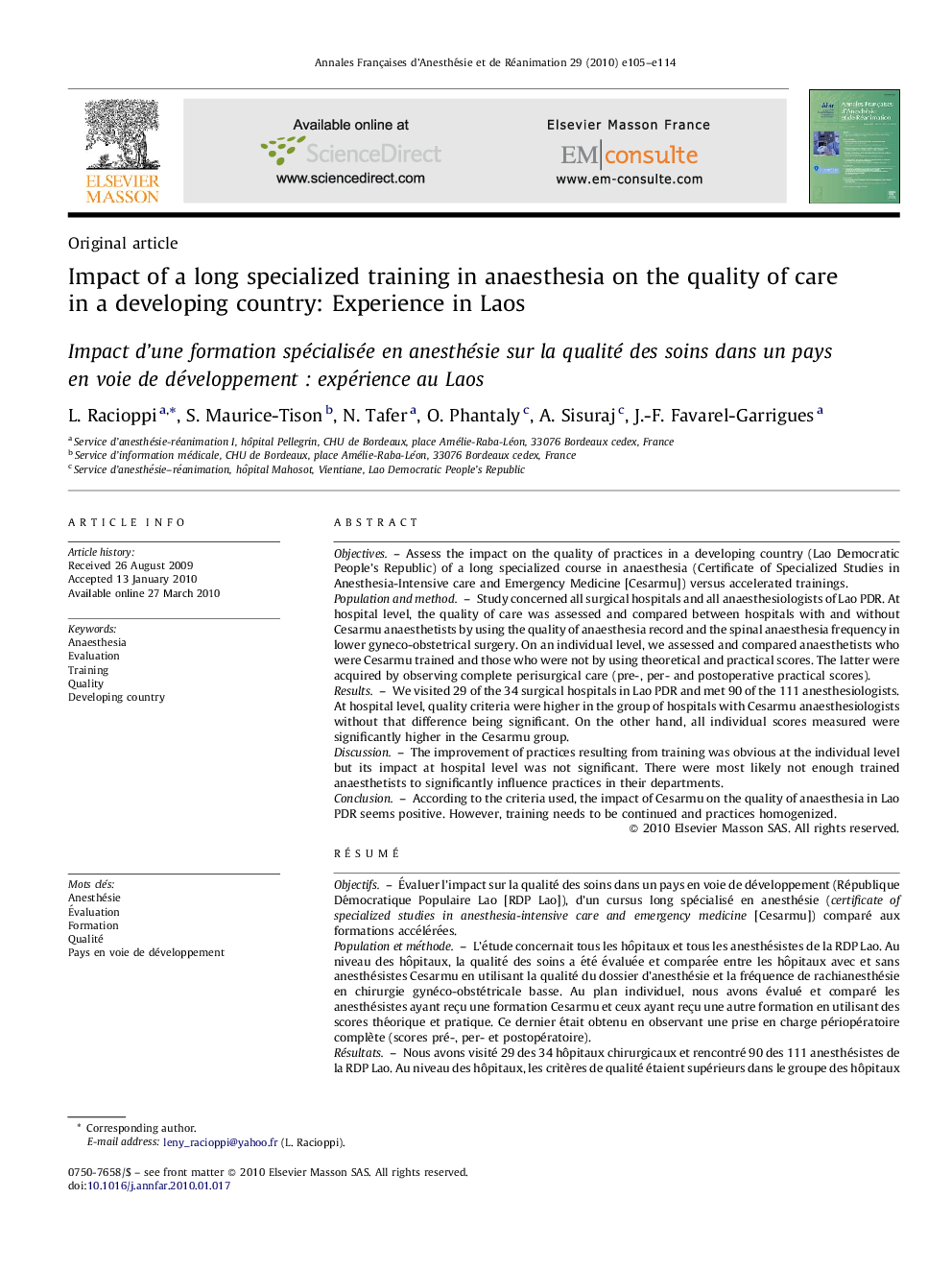| کد مقاله | کد نشریه | سال انتشار | مقاله انگلیسی | نسخه تمام متن |
|---|---|---|---|---|
| 2746263 | 1148868 | 2010 | 10 صفحه PDF | دانلود رایگان |

ObjectivesAssess the impact on the quality of practices in a developing country (Lao Democratic People's Republic) of a long specialized course in anaesthesia (Certificate of Specialized Studies in Anesthesia-Intensive care and Emergency Medicine [Cesarmu]) versus accelerated trainings.Population and methodStudy concerned all surgical hospitals and all anaesthesiologists of Lao PDR. At hospital level, the quality of care was assessed and compared between hospitals with and without Cesarmu anaesthetists by using the quality of anaesthesia record and the spinal anaesthesia frequency in lower gyneco-obstetrical surgery. On an individual level, we assessed and compared anaesthetists who were Cesarmu trained and those who were not by using theoretical and practical scores. The latter were acquired by observing complete perisurgical care (pre-, per- and postoperative practical scores).ResultsWe visited 29 of the 34 surgical hospitals in Lao PDR and met 90 of the 111 anesthesiologists. At hospital level, quality criteria were higher in the group of hospitals with Cesarmu anaesthesiologists without that difference being significant. On the other hand, all individual scores measured were significantly higher in the Cesarmu group.DiscussionThe improvement of practices resulting from training was obvious at the individual level but its impact at hospital level was not significant. There were most likely not enough trained anaesthetists to significantly influence practices in their departments.ConclusionAccording to the criteria used, the impact of Cesarmu on the quality of anaesthesia in Lao PDR seems positive. However, training needs to be continued and practices homogenized.
RésuméObjectifsÉvaluer l’impact sur la qualité des soins dans un pays en voie de développement (République Démocratique Populaire Lao [RDP Lao]), d’un cursus long spécialisé en anesthésie (certificate of specialized studies in anesthesia-intensive care and emergency medicine [Cesarmu]) comparé aux formations accélérées.Population et méthodeL’étude concernait tous les hôpitaux et tous les anesthésistes de la RDP Lao. Au niveau des hôpitaux, la qualité des soins a été évaluée et comparée entre les hôpitaux avec et sans anesthésistes Cesarmu en utilisant la qualité du dossier d’anesthésie et la fréquence de rachianesthésie en chirurgie gynéco-obstétricale basse. Au plan individuel, nous avons évalué et comparé les anesthésistes ayant reçu une formation Cesarmu et ceux ayant reçu une autre formation en utilisant des scores théorique et pratique. Ce dernier était obtenu en observant une prise en charge périopératoire complète (scores pré-, per- et postopératoire).RésultatsNous avons visité 29 des 34 hôpitaux chirurgicaux et rencontré 90 des 111 anesthésistes de la RDP Lao. Au niveau des hôpitaux, les critères de qualité étaient supérieurs dans le groupe des hôpitaux ayant des anesthésistes Cesarmu sans que cette différence ne soit significative. Par ailleurs, tous les scores individuels étaient significativement supérieurs dans le groupe Cesarmu.DiscussionL’amélioration des pratiques liée à la formation était nette sur le plan individuel mais son impact au niveau des hôpitaux n’était pas significatif. Il n’y avait probablement pas assez d’anesthésistes formés pour influencer significativement les pratiques dans leurs services.ConclusionSelon les critères utilisés, l’impact du Cesarmu sur la qualité de l’anesthésie en RDP Lao semble positif. Cependant, la formation doit être poursuivie et les pratiques homogénéisées.
Journal: Annales Françaises d'Anesthésie et de Réanimation - Volume 29, Issue 5, May 2010, Pages e105–e114